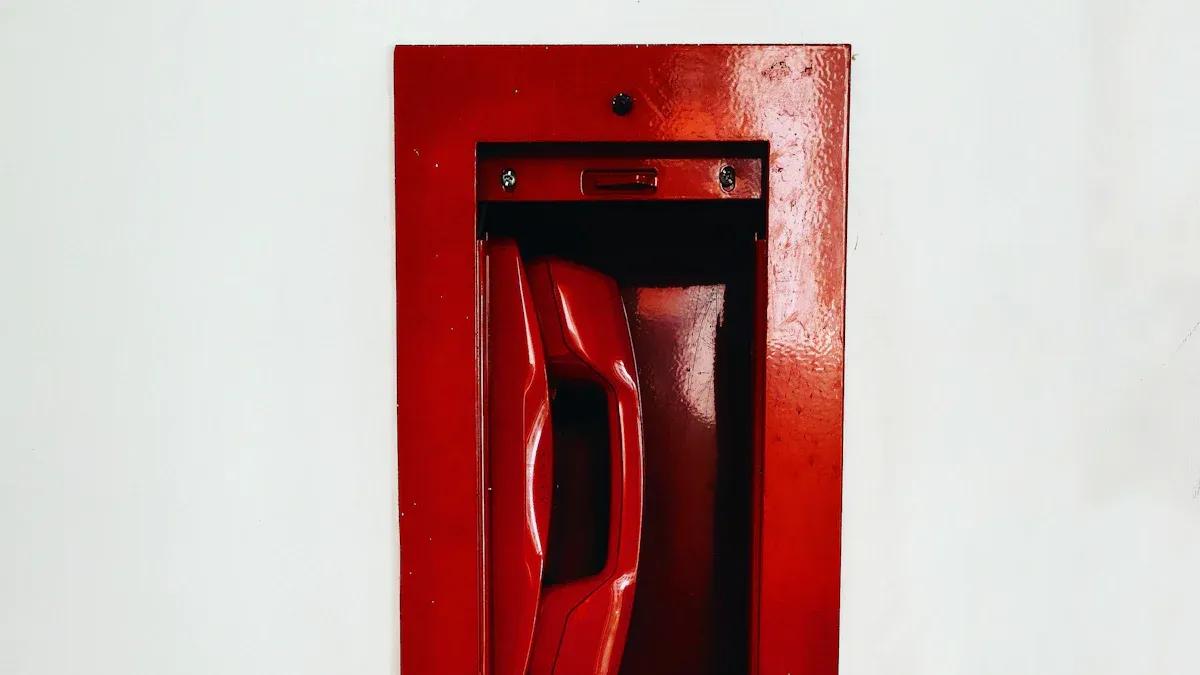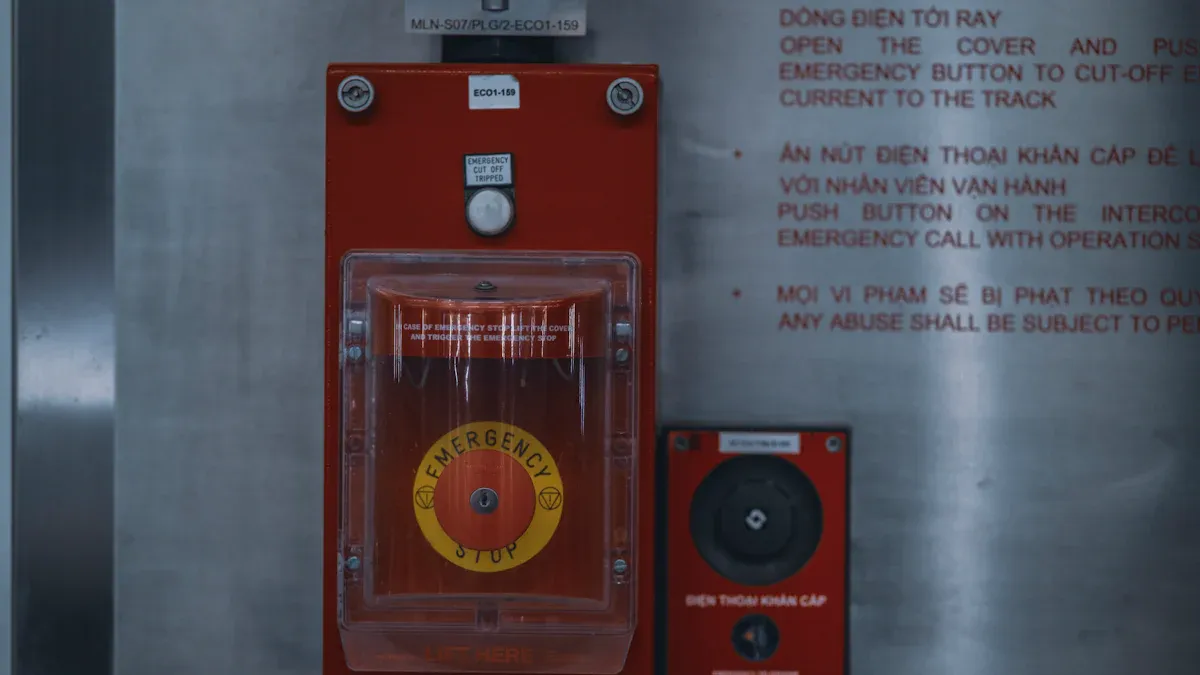
A reliable firefighter telephone handset consistently provides clear, uninterrupted communication in demanding and dangerous environments. This reliability is crucial. Effective communication means the difference between life and death. It ensures coordinated efforts, rapid response, and the safety of firefighters and those they rescue.
Key Takeaways
- A reliable firefighter handset is very strong. It can handle drops, water, dust, and extreme heat. This keeps it working in tough situations.
- Clear sound is important for firefighters. Handsets use special tech to block noise. This helps firefighters hear and speak clearly.
- Safety is key for these handsets. They meet strict rules and have features like emergency buttons. This protects firefighters during dangerous work.
Uncompromising Durability and Design for a Firefighter Telephone Handset

Firefighters face incredibly harsh conditions. Their communication tools must withstand extreme abuse. A reliable handset needs to be tough and easy to use. Its design directly impacts a firefighter’s safety and effectiveness.
Impact Resistance for Firefighter Telephone Handsets
Firefighters often work in chaotic environments. They might drop their equipment. Debris could fall on their gear. A handset must survive these impacts. Manufacturers build these devices with reinforced casings. They also include shock-absorbing materials inside. This design helps the handset keep working even after a hard fall.
Water and Dust Proofing (IP Rating) for Firefighter Telephone Handsets
Water from hoses, rain, and dust from collapsed structures are common at fire scenes. A reliable handset needs protection from these elements. This is where an IP (Ingress Protection) rating becomes important. For example, an IP67 or IP68 rating means the device can resist dust completely. It also handles being submerged in water for a certain time. This ensures the handset stays dry inside and functions correctly.
Temperature Extremes Resistance in Firefighter Telephone Handsets
Firefighters operate in intense heat and sometimes freezing cold. Their equipment must perform reliably in both extremes. The materials used in a handset must withstand very high temperatures without melting or failing. They also need to work in sub-zero conditions without freezing up. This ensures communication remains clear, no matter the weather or fire intensity.
Chemical and Corrosion Resistance in Firefighter Telephone Handsets
Fire scenes can expose equipment to various chemicals. These might include fuels, hazardous materials, or even harsh cleaning agents after an incident. A durable handset resists chemical damage. Its materials do not corrode or break down when they touch these substances. This extends the device’s lifespan and keeps it safe for use.
Intuitive Design and Ergonomics for Firefighter Telephone Handsets
Firefighters need to focus on their mission, not on figuring out their gear. A handset’s design must be simple and straightforward. It allows for quick and efficient operation, even under high stress. An intuitive design means firefighters can use the device without thinking too much about it.
Glove-Friendly Controls for Firefighter Telephone Handsets
Firefighters wear thick, protective gloves. These gloves make it hard to press small buttons. Handsets must have large, tactile buttons. These controls provide a clear click or feel when pressed. This allows firefighters to operate the device accurately, even with bulky gloves on.
Ergonomic Grip for Firefighter Telephone Handsets
A firefighter might hold their handset in wet conditions or with gloved hands. A secure grip is essential. Handsets often feature textured surfaces or specific shapes. These designs prevent the device from slipping. A good ergonomic grip ensures firefighters maintain control of their communication.
Backlit Displays for Firefighter Telephone Handsets
Visibility can be very poor in smoky buildings or at night. A handset needs a display that firefighters can read easily. Backlit displays illuminate the screen. This ensures firefighters can see important information, like caller ID or menu options, in any lighting condition.
Lightweight and Compact Form Factor for Firefighter Telephone Handsets
Firefighters carry a lot of heavy equipment. Every extra pound matters. A reliable firefighter telephone handset should be lightweight and compact. This design reduces the overall burden on the firefighter. A smaller size also makes it easier to carry and store the device on their gear.
Crystal-Clear Audio and Robust Connectivity in a Firefighter Telephone Handset
Effective communication relies on clear audio and a strong connection. Firefighters operate in environments where every word matters. Their equipment must deliver messages without fail. This section explores the features that ensure crystal-clear sound and robust connectivity.
Noise Cancellation Technology for Firefighter Telephone Handsets
Fire scenes are incredibly loud. Sirens blare. Alarms ring. Collapsing structures create deafening noise. Firefighters need to hear and be heard clearly. Noise cancellation technology actively filters out this background chaos. It makes voices much clearer. This ensures critical messages get through without distortion. It allows firefighters to focus on the message, not the surrounding din.
High-Fidelity Speaker and Microphone in a Firefighter Telephone Handset
A reliable handset features a high-fidelity speaker and microphone. The speaker delivers incoming messages with crisp clarity. It reproduces voices accurately. A sensitive microphone captures the firefighter’s voice precisely. It minimizes muffling or static. This combination prevents miscommunication. It ensures every command and report is understood perfectly.
Volume Amplification for Firefighter Telephone Handsets
Sometimes, even with noise cancellation, the environment is too loud. Firefighters wear protective gear. This gear can muffle sounds. The handset needs volume amplification. This feature allows users to boost the audio output significantly. It ensures they catch every word, even in the most extreme noise. Adjustable volume controls are also crucial for different situations.
Hearing Aid Compatibility (HAC) in Firefighter Telephone Handsets
Modern communication devices must be inclusive. Some firefighters use hearing aids. A reliable handset offers Hearing Aid Compatibility (HAC). This technology reduces interference. It allows the handset to work seamlessly with hearing aids. This ensures all team members can communicate effectively. It supports the diverse needs of emergency personnel.
Secure and Reliable Connection Interface for Firefighter Telephone Handsets
The connection interface is the lifeline of communication. It must be secure and reliable. This could involve a robust wired connection to a radio. It might also use a stable wireless link. The interface needs to withstand tugs, pulls, and harsh conditions. It prevents accidental disconnections. A secure connection guarantees uninterrupted communication when it matters most.
Long-Lasting Battery Life for Firefighter Telephone Handsets
Missions can extend for many hours. Firefighters cannot afford a dead battery. The handset’s power source must endure the entire operation. This ensures continuous communication from start to finish. Manufacturers design these batteries for extended use. They prioritize longevity under demanding conditions.
Easy Battery Replacement and Charging for Firefighter Telephone Handsets
When the battery runs low, firefighters need to swap it quickly. They cannot waste precious time. Handsets feature easy battery replacement mechanisms. This allows for rapid changes in the field. Charging solutions are also simple and efficient. Drop-in chargers or quick-connect ports minimize downtime. This keeps the equipment ready for immediate deployment.
Safety Compliance and Operational Standards for a Firefighter Telephone Handset
Firefighters work in dangerous situations. Their equipment must meet strict safety and operational standards. These standards ensure the gear performs reliably and keeps them safe. You can trust a handset that follows these rules.
Certifications (e.g., NFPA, UL) for Firefighter Telephone Handsets
Certifications are like quality stamps. Organizations like NFPA (National Fire Protection Association) and UL (Underwriters Laboratories) set tough rules. They test equipment rigorously. A certified Firefighter Telephone Handset meets these high benchmarks. This means it performs as promised, even in extreme conditions. These certifications give firefighters confidence in their tools.
Intrinsic Safety (Explosion Proofing) for Firefighter Telephone Handsets
Some fire scenes involve explosive gases or dust. A spark from equipment could cause a disaster. Intrinsic safety prevents this. It means the handset’s design stops it from creating sparks or too much heat. This feature protects firefighters in hazardous, potentially explosive atmospheres.
Emergency Button and Lone Worker Functions in Firefighter Telephone Handsets
Firefighters sometimes work alone or get into trouble. An emergency button offers a quick way to call for help. Just press it, and an alert goes out. Lone worker functions add another layer of safety. They can detect if a firefighter stops moving for too long. The system then automatically sends an alert. These features are vital for firefighter safety.
Priority and Voting Scan Capabilities for Firefighter Telephone Handsets
Communication channels can get busy. Priority scan lets a firefighter monitor important channels while still listening to others. Voting scan helps too. It automatically picks the strongest radio signal from different towers. This ensures clear, uninterrupted communication, even in areas with weak signals.
Ultimately, a reliable firefighter telephone handset is a critical tool. It performs flawlessly when lives are on the line. Its reliability comes from extreme durability, superior audio clarity, and user-centric design. Robust connectivity and strict safety standards also contribute. All these elements work together. They ensure seamless communication in the most challenging scenarios.
FAQ
What does an IP rating mean for a firefighter telephone handset?
An IP rating shows how well a device resists dust and water. For example, IP67 means it handles dust completely. It can also go into water for a short time.
Why is noise cancellation important in a firefighter telephone handset?
Fire scenes are very loud. Noise cancellation technology filters out background sounds. This makes voices clearer. Firefighters can then hear critical messages without distortion.
What are NFPA and UL certifications for a firefighter telephone handset?
These are important safety certifications. NFPA (National Fire Protection Association) and UL (Underwriters Laboratories) test equipment. They ensure the handset meets high safety and performance standards.

